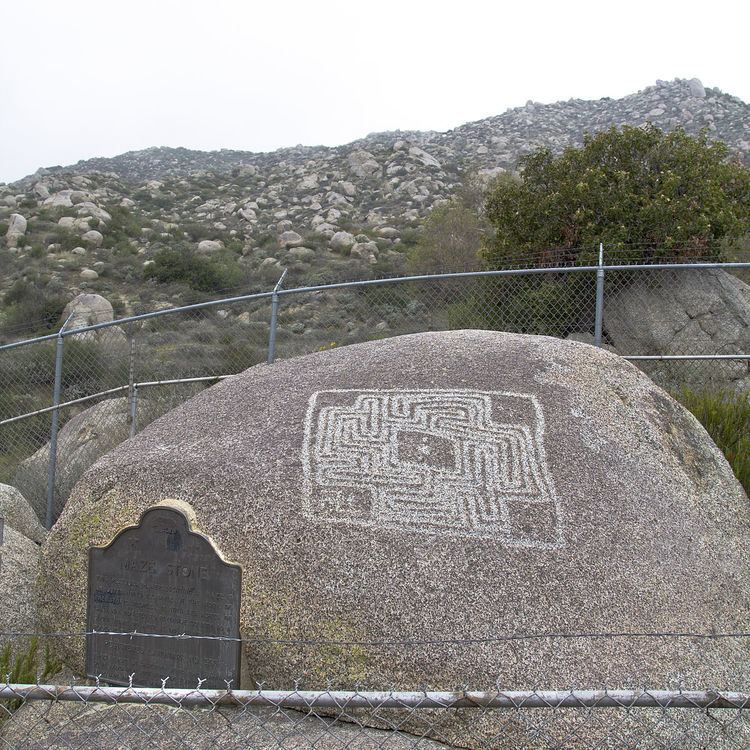Reference no. 557 | Phone +1 951-765-3712 | |
 | ||
Similar Ramona Bowl Amphitheater, Gibbel Park, Hemet Museum, Lake Hemet, Simpson Park | ||
Tdw 1286 unusual unexplained hemet maze stone
33°46′54″N 117°03′23″W
Contents
The Hemet Maze Stone is a prehistoric petroglyph. It is just outside Hemet in Reinhardt Canyon, within the Lakeview Mountains, in Riverside County, California. On April 16, 1956, it was donated, along with 5.75 acres (23,300 m2) of land, to Riverside County, by Mr. and Mrs. Rodger E. Miller. It is California Historical Landmark No.557. The government has installed two perimeter chain link fences around the petroglyph landmark, making direct appreciation, study or an unobstructed picture difficult. The surrounding land has been set aside for the protection of native plants and animals (with a warning that the “natural features may be hazardous”), and is at the end of California Avenue to the north of Highway 74 and east of Highway 215, near Hemet, California. According to a sign where the road has been blocked off to prevent people from driving closer to the Maze Stone, people with questions can call the Riverside County Parks Open Space Office at 909-245-1212.
Lets go 2 the hemet maze stone
Features
The "maze" consists of two rectangular boxes—one large and containing the other; centered. If one traces the patterns with different colored markers, one would find that between the boxes are two contiguous geometric patterns that resemble a maze. One "maze" is contained by the other on the left hand side.
The swastika that appears in the lower left hand corner is not part of the original work as evidenced by a 1930s era photo featured in the Hemet Centennial calendar (featured photo of July 2010; available from the Hemet Museum located at the old train depot on the northwest corner of State and Florida). Swastikas were used in Native American art long before the symbol became associated with Adolf Hitler.
The maze petroglyph, depending upon interpretation, could show four walled structures or areas, consisting of two simple objects and two “maze-like” complex objects. There is an inner and outer object for each type of simple or complex object. To reference the diagram called “Conceptual Approximation of the Maze Stone near Hemet, California,” the "simple" objects are denoted by the square/rectangular black (outer) and gray/beige (inner) lines. The gray/beige area is filled in and appears as a rectangular object. What the computer considers a gray color, other people say is the color beige. The "complex" objects are blue (outer) and purple (inner). Notice how the purplish complex object is completely surrounded by the blueish complex object. The inner objects are completely surrounded in the space created by the outer objects. The blueish object seems to surround the simple gray object in the center, but is unable to completely do so, and the gray/beige object is either directly attached and is completely surrounded by the space associated with the outer black boundary wall that surrounds the whole “maze.” Taking away or adding the blue and purple areas makes no difference to the relationship between the inner gray/beige object and the outer black boundary line, as the space between them is still connected. The space inside the black line was left white/blank. Be aware the diagram was created with visual guesswork from multiple pictures using a computer graphics program to draw straight, colorized lines without measurements.
The petroglyph appears to be a square, although the attempt to redo the diagram by computer produced better results when slightly elongated into a rectangle. Also the original is on the slightly curved surface of a stone, although there were flatter stones that could have been chosen in the region. Can the maze be recreated in a square while attempting to keep all the lines uniformly separated on a flat surface is a question that arose while creating the conceptual approximation diagram. Since there are ten lines to be crossed on the top, bottom, left and right of the original petroglyph, it stands to reason the idealized version of the “maze” could fit into a square.
The original design constraints and reasoning behind the prehistoric design are not clear to us even today, but show in the choices made while creating the “maze.” To give a few examples, at any given spot in the blueish space, there are up to three possible directions to follow, not the four directions possible when 90 degree line segments join together. The outside edge of the outer complex object shows the outline of the inner complex object three times. There are three “dead ends” (in maze terminology) to the blueish-object’s area. If one is looking at the spot where two of the blueish ends meet before reaching the inner complex object on the left side, one would have had to transverse six straight segments to reach that point – from either end point. The analysis discussion can also be changed by switching the walls to pathways and the pathways to be impassable areas, but the “maze” has design features that have nothing to do with a conventional “maze” where the objective is to go from a starting point to an ending point through a confusing set of passageways. The Maze Stone is certainly not what we would think of as a regular maze, even though it may look like one. Without knowing the original intent of the creator, we do not know if the maze represents an engineering drawing, a symbol, an artistic concept or something else. Any meaning for the petroglyph remains an enigma.
This petroglyph is classified as California Engraved, within the California Tradition of rock art.
